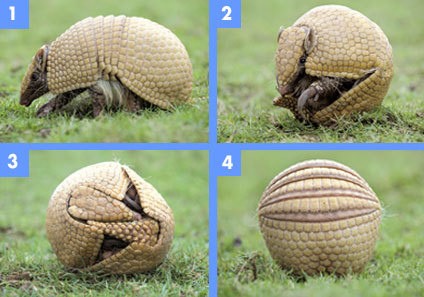Armadillo
Of the 20 varieties of armadillo, all but one live in Latin America. The familiar nine-banded armadillo is the only species that includes the United States in its range.
Armadillo is a Spanish word meaning “little armored one” and refers to the bony plates that cover the back, head, legs, and tail of most of these odd looking creatures. Armadillos are the only living mammals that wear such shells.
Closely related to anteaters and sloths, armadillos generally have a pointy or shovel-shaped snout and small eyes. They vary widely in size and color, from the 6-inch-long (15-centimeter-long), salmon-colored pink fairy armadillo to the 5-foot-long (1.5-meter-long), dark-brown giant armadillos. Others have black, red, gray, or yellowish coloring.
Contrary to popular belief, not all armadillos are able to encase themselves in their shells. In fact, only the three-banded armadillo can, curling its head and back feet and contorting its shell into a hard ball that confounds would-be predators.
Armadillos live in temperate and warm habitats, including rain forests, grasslands, and semi-deserts. Because of their low metabolic rate and lack of fat stores, cold is their enemy, and spates of intemperate weather can wipe out whole populations.
Most species dig burrows and sleep prolifically, up to 16 hours per day, foraging in the early morning and evening for beetles, ants, termites, and other insects. They have very poor eyesight, and utilize their keen sense of smell to hunt. Strong legs and huge front claws are used for digging, and long, sticky tongues for extracting ants and termites from their tunnels. In addition to bugs, armadillos eat small vertebrates, plants, and some fruit, as well as the occasional carrion meal.
Population numbers of nearly all species are threatened by habitat loss and over-hunting. Many cultures in the Americas consume armadillo flesh, which is said to resemble pork in its flavor and texture. Currently, only the nine-band population is expanding, and some species, including the pink fairy, are threatened.
- Type:
- Mammal
- Diet:
- Omnivore
- Average life span in captivity:
- 12 to 15 years
- Size:
- 5 to 59 in (13 to 150 cm)
- Weight:
- 3 oz to 120 lbs (85 g to 54 kg)
- Protection status:
- Threatened
- Did you know?
- The nine-banded armadillo’s hapless propensity for being run over by cars has earned it the nickname “Hillbilly Speed Bump.”
- Size relative to a 6-ft (2-m) man:
They are such strange creatures and want to see how I can make one as a puppet.
It needs to be able roll up into a ball.
Looking at the skeleton will help me get the structure of the armadillo right.






No comments:
Post a Comment